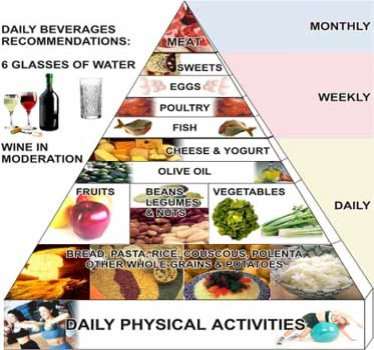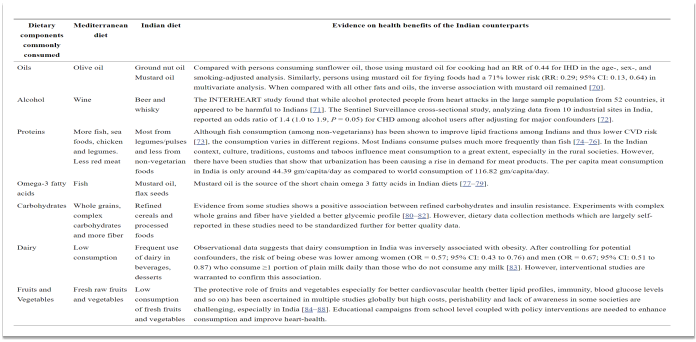Comparison of Indian and Mediterranean Diet
| ✅ Paper Type: Free Essay | ✅ Subject: Sciences |
| ✅ Wordcount: 1775 words | ✅ Published: 12 Sep 2017 |
“INDIAN DIET OVER MEDITERRANEAN DIET”

13 MARCH 2017
Introduction
In nutrition, the term “diet” refers to the intake of adequate quantity of essential nutrients which are vital for the effective functioning of the body and various metabolic mechanisms. Humans, in general practice an omnivorous diet but the dietary pattern of people vary in accordance with the region and personal diet preferences. The selective dietary behaviour among people led to the emergence of various type of diet categories such as ketogenic diet, fruitarian diet, vegan diet, pescetarian diet and carnivorous diet.
Mediterranean diet emphasizes on the intake of plant based foods, healthy fats such as canola and olive oil, alcohol in moderate quantity, fish and poultry instead of red meat which is considered to be a balanced health diet and the Indian diet includes a higher proportion of carbohydrates. The essay specifically focuses on comparing the dietary pattern of Indian and Mediterranean diet.
Literature review
- Mediterranean diet
Mediterranean diet refers to the traditional dietary pattern that is highly practiced in the Mediterranean region. The traditional Mediterranean emphasize on the higher consumption of fruits and nuts, legumes, unprocessed cereals, minimal consumption of meat and dairy products. Adefinition to Mediterranean diet was first made by Ancel Keys as the diet which is low in saturated fats and high in vegetable oils which was initially observed in Greece and Southern region of Italy. Olive oil constitutes the key element in the Mediterranean diet and the monounsaturated fatty acid and antioxidant content in olive has found to exhibit profound effect in the control of coronary heart diseases, various cancers and age-related cognitive disorders(Keys, 1995). Olive oil comprises about 55-85% of monounsaturated oleic acid content and rich in antioxidant compounds such as vitamin E and a range of phenolic compounds such as hydroxytyrosol, tyrosol and complex phenolic compounds (Visioli & Galli, 2001). The unique feature regarding the Mediterranean diet when compared with other healthy diets is that it limits the intake of alcohol during meal and the source of fat in the Mediterranean diet are Virgin olive oil, tree nuts and fatty fish. Another key ingredient of the Mediterranean diet is the legume which has proven to lower the incidence of coronary heart disease (CHD). Legumes are composed of larger proportion of bean protein and water soluble fibres and serves as a good source of proteins, vitamins, minerals, omega-3 fatty acids and non-starch polysaccharides. Fish is another prime ingredient of the Mediterranean diet which is a rich source of long chain omega-3 fatty acids and confers a lot of health benefits. Alcohol intake pattern in the Mediterranean diet has considerably decreased the mortality rate. Recent research studies have shown that the traditional Mediterranean diet reduces the incidence of breast cancer, Parkinson’s disease, Alzheimer’s disease and cardiac diseases(Trichopoulou et al., 2014).
- South Indian diet
The Indian traditional foods are referred to as functional foods as it includes functional components such as body-healing chemicals, dietary fibres and probiotic constituents in it. The functional properties are enhanced via food processing techniques such as sprouting, malting and fermentation. The typical dietary pattern of south India includes the grain-based foods such as idly, Dosa (fermented foods), white or brown rice, dhals such as toor, urad, Bengal gram and mung, animal protein foods include fish, chicken, lamb, mutton and eggs, green and starchy vegetables, fruit or fruit juices, desserts such as kheer made from reduced milk and white sugar, jilebi , appam and Pongal made from brown sugar based cooked rice and lentils and desserts made out of jaggery such as Halwa (MISRA, 2011).The grain-based foods have a high calorific value and confer a lot of health benefits when included in diet. Idly and dosa falls under the category of fermented food products prepared from rice and black gram by steam cooking. Fermentation process enhances the nutritional and protein efficiency value and the fermentative bacteria is capable of synthesising vitamin B12 and beta-galactosidase enzyme which promotes the promotes the probiotic activity and confer health benefits. Idly is more digestible due to fermentation process and is widely consumed as breakfast meal. The food stuff that is widely consumed for lunch include the rice meal which include the rice, dahi (Indian yogurt), Non-vegetarian and vegetarian dishes. The rice meal is rich in carbohydrates , Vegetable dishes such as Sambar ( mixed vegetable curry), Rasam ,Vazhai poo poriyal which is prepared out of small chopped pieces of banana floret seasoned with green chilly, mustard, onion and coconut which is highly nutritious and is effective against diabetes and heart burn , Non-vegetarian dishes are prepared out of red meat which are rich gravies composed of saturated fats and salts , dahi or Indian yogurt is rich in B-complex vitamins, folic acid and riboflavin and lactic acid bacteria which exhibit probiotic effect and controls diarrhoea in children . The dinner preparation includes the chapatti (indian bread) which is made out of wheat flour and fish gravy (indian style fish curry). Wheat is highly nutritious due to its high content of protein and fibre. Similarly, the fish used in the diet is rich in omega-3 fatty acids, proteins and minerals which makes it an ample diet as it confers a lot of health benefits. (Sarkar, Dhumal, Panigrahi, & Choudhary, 2015)
- Comparative study of Indian diet with Mediterranean diet and other diets(Trichopoulou et al., 2014)
- Oil used:
In India cooking oils differ region wise, certain mono unsaturated fatty acid like ground nut oil, mustard oil and rice bran oil commonly used in India has similar nutritional properties to olive oil which is widely used in the Mediterranean. However, oils used in India don’t show any impact on the cardio-protectiveness though certain studies on the usage of mustard oil shows 50% reduction in the risk of ischemic heart diseases. Whereas usage of rice barn oil shows effect on hypolipidemia and further studies on these oils also show positive effects on the cardiovascular health. Despite the positive effects of olive oil, it is not considerably used in India due to the traditional cooking methods, availability and the cost of olive oil. Olive oil not being an indigenous is not commonly available and is quite expensive making it less popular however subsidises provided from the Agricultural ministry on olive oil and olive cultivation along with its nutritional facts is developing interest among people in India.
- Fruits and Vegetables:
Mediterranean diet’s key factor is the high consumption of fresh fruits and vegetables. Indian diet shows low consumption in fruit and vegetables compared to Mediterranean diet despite India being the second largest producer of fruits and vegetables in the world. The main reasons noted for low consumption of fruits and vegetables are availability, affordability and lack of awareness. Early start, multi- component interventions and subsidies on growing and storing of fruits and vegetables may offer supportable solutions on promoting intake of fruits and vegetables in India.
- Legumes:
Another important Mediterranean diet is the consumption of legumes. Legumes reduces the Coronary heart disease risk and is high in protein and fibre. Legumes are also found to be rich in vitamins, minerals, omega-3 fatty acids and non-starch polysaccharides. Even though Indian diet contains a legume it is not up to the ideal consumption levels. India has a high production rate of legumes despite the intake levels, this is due to the cost factor. The challenge lies in increasing production rate at a lower cost, which makes legumes affordable for everyone in India.
- Fish:
Fish plays a vital role in Mediterranean diet, due to its long chain omega 3 fatty acids(n-3) it is known for being very heart healthy. Fish intake ratio in India depends from region to region considerably, whereas it is widely consumed in the Mediterranean. Alternate source of n-3 in India is commonly nuts, flax seeds and mustard oil, but it contains shorter chains of n-3 compared to fish.
- Drinks:
Mediterranean diet consists of mainly wine as drink, whereas in India whiskey and beer are highly consumed instead of wine. The consumption pattern of alcohol also varies between the Mediterranean and India, for instance in India alcohol is consumed before food as compared to the Mediterranean where it is consumed along with food. This pattern and the type of alcohol consumed has effects on the risk of CVD.
- Meat:
High CVD risk is associated with red meat intake, people following Mediterranean diet usually consumes less red meat. The United Nation food and Agricultural organization reported a rise in meat consumption in India, this shows there is change in the usual dietary preferences. Religion plays a main part in meat diet in India, Hindus usually avoid beef and Muslims avoid pork among the non-vegetarian population in India.
 The comparison of Mediterranean and Indian diet is elucidated in table 1
The comparison of Mediterranean and Indian diet is elucidated in table 1
Summary:
The Mediterranean diet shows it is a balanced diet all together, whereas the diet particularly followed in India has all the required nutrients but doesn’t meet the required standard to meet a complete nutritional balanced diet. This can be mainly noted due to regional food being more available than the others and as well as the fact of affordability of certain food items, pattern of dietary consumption in India also does play a role in it. Despite this the constituents of the Mediterranean diet plays separate roles in their relationship with one another and with the items which are consumed alongside with the diet. Therefore, fusing Mediterranean diet with the traditional Indian food processing methods followed in the Indian diet to create mixed dishes could affect few of the preventive and nutritional benefits that Mediterranean diet alone holds, and this could also lead to increased risk of CVD substantially. Thus, successful dietary interventions should be implemented mainly for the patterns of diet followed instead of having isolated nutrients along with usual diet, hence aiding to develop an ample, stable and nutritional diet. The Ministry should also see to it that there are enough food items available at affordable rates so that adequate portions of food is consumed, thus meeting the ample nutritional standards in the diet.
References:
Keys, A. (1995). Mediterranean diet and public health: personal reflections. The American journal of clinical nutrition, 61(6), 1321S-1323S.
MISRA, R. M. R. (2011). Indian Foods: AAPI’s Guide Indian Foods: AAPI’s Guide To Nutrition, Health and Diabetes: Chennai: Sunil Sachdev.
Sarkar, P., Dhumal, C., Panigrahi, S. S., & Choudhary, R. (2015). Traditional and ayurvedic foods of Indian origin. Journal of Ethnic Foods, 2(3), 97-109.
Trichopoulou, A., Martínez-González, M. A., Tong, T. Y., Forouhi, N. G., Khandelwal, S., Prabhakaran, D., . . . de Lorgeril, M. (2014). Definitions and potential health benefits of the Mediterranean diet: views from experts around the world. BMC medicine, 12(1), 112.
Visioli, F., & Galli, C. (2001). The role of antioxidants in the Mediterranean diet. Lipids, 36, S49-S52.
Cite This Work
To export a reference to this article please select a referencing stye below:
Related Services
View allDMCA / Removal Request
If you are the original writer of this essay and no longer wish to have your work published on UKEssays.com then please click the following link to email our support team:
Request essay removal



